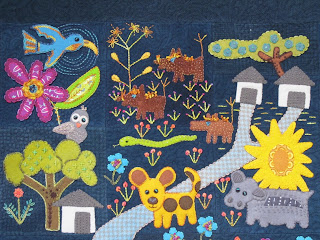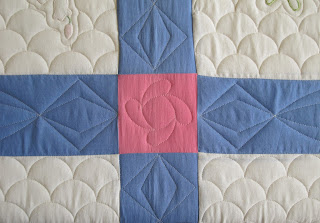Welcome back to the
Vintage Series!
Though I've had a few vintage quilts to talk about since my last Vintage Series post on June 6, 2014, I'm returning to the 'official Vintage Series format' which I hope you continue to enjoy.
 |
| O. O. Howard house today |
My backdrop today will be the General O. O. Howard House. The Howard House was the last historic structure to be rehabilitated on Officers Row, an area that served as residential housing for many of the soldiers, officers and families stationed at Vancouver Barrack. The original Officers Row is pictured, below.
Anchoring the stately, tree-lined boulevard's western end, the home is named for its first inhabitant, Gen. Oliver Otis Howard (1830 - 1909).
 |
| Officers Row |
Recipient of the Congressional Medal of Honor in the Civil War, Howard was the first head of the Freedman's Bureau, established in 1865 to aid former slaves. From 1874 - 1880, Gen. Howard was Commander of the U. S. Army's Department of the Columbia in Vancouver.
 |
| O. O. Howard House in the late 1800s |
The house that bears his name was built in 1879 and is an excellent example of late - 19th century Italianate - style architecture. The first to occupy its grand halls and rooms was Gen. Howard and his family.
It's a perfect home caught in time to stage these quilts that are also remnants of an era long gone. It only seems appropriate to get into a bit of quilting history around the era of this pink, blue and white beauty. But first, let's talk quilting procedure.

I found this late 1920s embroidered quilt top antiquing in Pueblo, Colorado eight years ago and paid a good price for it, even though there were (and still are) a few holes I tried desperately to repair. Why did I wait eight years to quilt it? Simply because I didn't have the foggiest idea how to make the uncentered embroidered motifs look perfectly centered. I didn't have the skills I wanted for this effect...yet.
Problem: As is true with any quilt top, the rows, blocks and sashing on this quilt are not perfectly square.
Solution: do you see the three bar magnets I have positioned to my belly bar? They are helping to hold the quilt top square as I baste the quilt top together. After basting each row I remove them, advance the quilt, check for squareness, and use them if necessary. By the time I'm finished with basting, this uneven quilt top will be convinced to be very square. This is vitally important if the quilt is to be hung on a wall for display, or even when it is positioned on a bed: it will drape evenly. This is especially important when a quilt is to be entered for show.
Even now while basting I don't have a clear plan on what techniques I'll be using to quilt it. But it's sat in my closet long enough and deserves to be finished. I have some good ideas though, which I marinate for a few nights after basting the quilt to the frame.
Here I've sped forward with my plan, forgetting (again) to take photos. To the right is a good preview of the freehand techniques used: SID inside each block and appliqué stitching around every embroidered motif to anchor the quilt.
 Then I engaged the computer belts and marinated digitized application. Initially, I wanted to place a feathered wreath at the center of each block, but knew since the embroidery wasn't centered, it would make the quilt look imbalanced.
Then I engaged the computer belts and marinated digitized application. Initially, I wanted to place a feathered wreath at the center of each block, but knew since the embroidery wasn't centered, it would make the quilt look imbalanced.
I ponder ideas a bit more and - tah dah! - I came up with a background fill, which would make each motif look like they're floating. I chose this clamshell design to suit the era in which the quilt top was pieced.
It works.
 |
| The sashing and cornerstones get some royal digitized treatment, too. |
Other blocks...
 |
| See how crooked this motif was placed in the block? Not a problem with the fill. |
 |
| Another uncentered motif, but the clamshells give a balance that otherwise isn't there. |
And now, the finished quilt (finally!) and some history behind the makings of it, originally.
The middle of the 1920s marked an abrupt change in the color of fabrics being produced.
Women may have wanted quilts that reminded them of their heritage, but they wanted them in the new pastel and light-bright color schemes. Designers promoted their dreamy floral appliqué designs, and quilting came to be seen as an art rather than a utilitarian craft.
Although a great many pieced quilts were made, appliquéd quilts were particularly prized. Interest in embroidery - such as the one I'm featuring - was also renewed and women sometimes incorporated it into their quilts.
Pre-stamped quilt blocks were sold with embroidery motifs. All this was well underway before the crash of 1929. The stage was set for a renewed love of quilting among American women...that continues today.
I hope you've enjoyed a step back in time
through this Vintage Series post. Come back soon for another trip to the Howard House.




























































